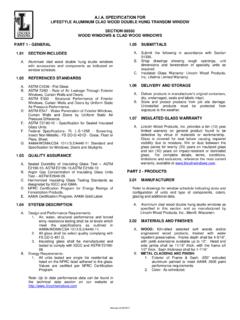Transcription of Alan Cuthbertson successfully double-glazed his own ...
1 60 ReNew 117 DIY double glazing journeyAlan Cuthbertson successfully double - glazed his own windows. When his job as a home sustainability assessor ended, he turned retrofitting windows into a business. He shares his tips for DIY thermal am a semi-retired computer pro-grammer with a degree in physics who became seriously concerned about climate change some five years ago. I became a Green Loans asses-sor two years ago, but that all ended earlier this year with the close of the program. I have focused on the thermal performance of my house to make it more sustainable, for instance using temperature probes to understand how my gas heater works so I can make it as efficient as fixed my roof insulation and worked on draught exclusion, my ef-forts then turned to fixing my windows. I added cheap pelmets to reduce heat loss, which are a simple design using a piece of plastic attached between the window frame and the curtain track.
2 I also have winter and summer routines with my blinds and windows, such as opening them overnight in summer to cool the house. On hot days I close all the blinds during the day as well, while in winter they are wide open during the day and closed at night. Fortunately I have only two small east and west facing windows and they have external shading in was left with a major source of heat loss though, that being the glass itself, so my aim was to double glaze them. I have achieved a lot over the last 18 months, but rather than just describe my final destination, I think the journey is also attemptsI thought the cheapest method would be to add a second layer of glass to the outside of the window, as this would avoid wasting the existing glass. This is actually secondary glazing, rather than double glazing. I read Michael Gunter s article DIY double glazing retrofit it s a snip!
3 In ReNew 84. He simply used a plastic frame which he sealed on the in-side of his window, then sealed a second sheet of glass to that. It worked for him, so I tried my own version. I decided to add the glass to the out-side since it was less intrusive. I simply laid it against the existing beading and held it in place with a second piece of beading. It worked a week. When it rained, it promptly fogged up. I then realised what causes fogging in a double - glazed system. Warm moist air enters the unit, cools down and deposits its moisture on the glass. This only happens if the air comes from inside the house. Air enter-ing from outside is normally cold so it enters the gap and warms up, removing moisture rather than depositing it. The fogging problem arose because moisture migrated through the frame to the wooden beading between the two layers of glass.
4 When the bead-ing warmed up, the water evaporated, condensing on the cold external glass. Based on Michael Gunter s solution I designed a plastic capping to cover the original beading and sealed it with silicone. I then added a rubber seal fol-lowed by the sheet of glass and external beading. This worked really well, except for a couple of windows which would still fog up after extended rain periods. I traced this to moisture seeping up the window sill. By placing three 3mm thick supports under the glass and un-der the bottom beading, the moisture tended not to seep up. Any that did soon all worked well, although I learnt two things. Firstly, using a plastic scourer to clean a window is not a good idea (it will scratch) and secondly, 3mm glass breaks very easily! Alan installing one of his DIY double glazing units with glass cut specially to ReNew 117 61 The design for a DIY double - glazed frameSiliconeSiliconeBeadingSealLow-E layerArgonSealBeadingRubber sealDouble- glazed unitRubber sealWindow frameRubber supportsDrain holeBetter glassBefore completing all the windows, I visited a friend who works in the glaz-ing business.
5 My aim was to get better and cheaper glass, rather than the 3mm glass from my local glazier. He recom-mended that I use 4mm low-E glass, which costs more but has almost half the heat loss when compared to normal glass. Low-E glass has a thin metallic film that is almost transparent in the visible and infrared regions, meaning that it does not obstruct the view or stop winter sun from entering. It is also highly reflective in the long wavelength range so in winter it reflects heat back into the room and in summer reflects the heat outside. Overall it reduces heat loss a further 30% compared to a normal double - glazed unit. The only downside is that it has a slight milky look to it when it s in direct an afterthought, I asked about the price of a double - glazed unit. It was surprisingly cheap, only 70% more than the cost of the low-E glass.
6 If I bought double - glazed units for half the house, I could reuse the old glass for secondary glazing. Effectively I would have proper double - glazed units on half the house, and secondary glazing on the remainder of the house for a much reduced promptly bought 15 double - glazed units, each with a low-E piece of glass and argon filling. The installation was remarkably easy. I just removed the old glass, added a rubber seal, then the window unit and some beading. The main problem I had was removing the old glass without breaking it. Out of ten windows with 3mm glass, I was only able to reuse two pieces of glass the rest cracked as I removed them. Two windows with 4mm glass both came out easily and were successfully reused. I have 11 secondary- glazed windows, and two show minor fogging occasion-ally I think I need to re-check the seals sometime. My feeling is that, although replacing a window with a double - glazed unit costs more, it does a better job and is less likely to cause long-term stepsSharing my knowledge with others would be worthwhile, and when I looked closer it seemed there was a business opportunity too.
7 I formed a company called DIY double Glaze and developed a website containing all of my how-to information. The idea was to provide either secondary glazing or double glazing, cut to size, for house-holders to install , my main concern offering a DIY double glazing service was the risk of the double glazing units failing. The two main causes of seal breakdown are ultraviolet light and moisture. The light is easily handled and the risk of mois-ture lying against the seals is minimised if you include weep holes at the bottom of the frame and 3mm setting blocks to keep the glass away from the bottom of the frame. I also recommend using silicone around the outside of the glass to stop water am learning that each house is dif-ferent. Over six months I have visited a number of homes and six have bought some windows to install. All intend doing all their windows if it works.
8 I ve had requests from Hobart and Adelaide and am working on the feasibility of shipping windows interstate. Homes in country Victoria are very keen on the idea; not only is it colder there but there is no natural gas so heating is more expensive than in Melbourne. Most of my own windows are dou-ble- glazed or secondary- glazed and I am pleased with the result. Summer cooling reduced a lot; if I get the house cool at night, then it s a lot longer before I need to use the air conditioner, some-times not at all. Admittedly, last summer was not as hot as the previous summer. Condensation on the inside of win-dows has virtually disappeared. When I measure the temperature on the inside of the glass the double - glazed units are several degrees warmer. Our gas bill has not reduced as much as I would have liked, but I am yet to get figures for a full Gaps were sealed throughout the house before more involved energy saving improvements.
9 62 ReNew 117 One reason for this is that the heavy curtains with pelmets installed earlier improve window performance significantly, so adding double glazing had less impact. Also, a family revolt means the heater is slightly warmer this year! RMore infoDIY double sheets of glass can be extremely hazardous and full safety steps should be taken. Suction cups are used in all instal-lations outlined in the article. However it s worth heeding the following advice given by Michael Gunter in his ReNew 84 article, DIY double glazing retrofit it s a snip!: Ladders must be strong, the operator must not be fatigued, and must have sufficient strength in the hands to confidently and securely grasp the glass. Ideally the method of installation should be carefully planned so that in the event the glass is dropped at any stage, no in-jury results. Larger panes, where you are not standing on the ground, would prob-ably necessitate a strong trestle platform and a trusted assistant.
10 Another clever retrofit: Alan reflects light into darker rooms with this external mirror. If you care for your health, the environment and the environment you are creating for yourself and your family at home, then why not paint your new or existing home with chemical free, toxin free, all natural paint? Create the colours of your choice with natural pigments. Put the play back into painting and create a beautiful background to your life with Natural : (02) 6584 |






